Soft Amish White Bread (Video, Beginner Friendly)
Amish white bread is a slightly rich, soft, yet sturdy yeast bread that’s perfect for beginners. I know bread recipes feel completely overwhelming, but this version (with video tutorial) has been successful for thousands of beginner bread bakers. You can master homemade bread!
Jump to Recipe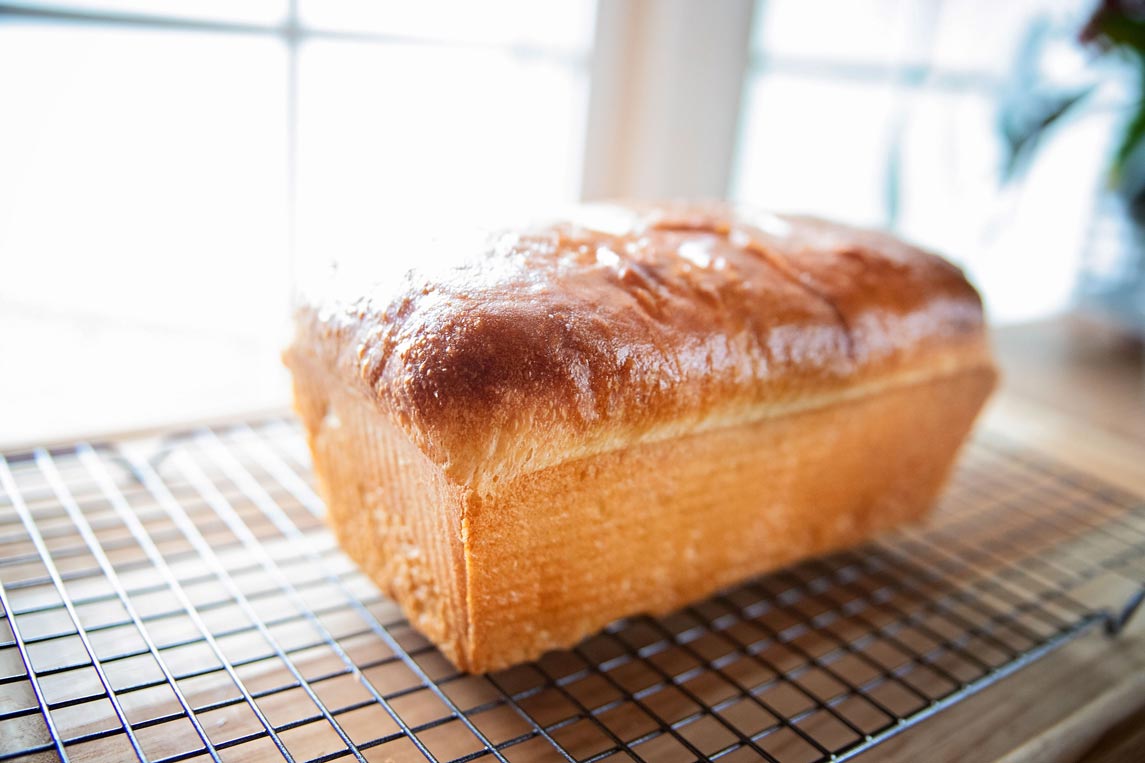
A bread baker for over 30 years (don’t tell anyone how old I am), I’ve taught beginner bread baking classes to dozens in my kitchen and to millions on YouTube. For every step in this post you can watch the companion video below and I encourage you to reference it often while mixing your first loaf.
I know all the things beginner bakers do wrong, and I’m going to help you fix those.
Watch the tutorial
Watch this video to see each step in action!
Table of contents
- Watch the tutorial
- 5 things beginner bakers do wrong and how to prevent them
- Common questions about Amish white bread
- For accuracy, measure your bread ingredients in grams
- Choose a loaf pan that heats evenly
- What your Amish white bread should look like at each stage
- Ideas for using stale bread
- Other ways to use your Amish white bread dough
5 things beginner bakers do wrong and how to prevent them
- Using water that’s too cold. Your yeast needs water slightly warmer than lukewarm. Like what you bathe a baby in, or about 110 degrees for those of you who don’t have kiddos. If it’s too cold, the yeast won’t activate or foam. This video shows you what yeast looks like when it’s alive. You can use active dry or instant yeast here. Activate them both in water the same way. Learn how to activate yeast in detail here.
- Cold ingredients will make rise time slow. Every ingredient you bake with needs to be room temperature. This includes your egg, and if you keep your flour in a freezer it needs to warm up too.
- Squishing the dough through your fingers and making a crazy mess. Your dough is not slime and you’re not a kindergartener. Keep your fingers closed like a scoop and work gently with the dough so it’s not stuck all between your fingers.
4. Smashing the dough too hard while kneading and making it sticky. Watch the video and notice that the dough isn’t getting smashed across the counter. Press down about 1/3-1/2 the depth of the dough. If you mash it too hard you’ll have a sticky mess. Learn more about kneading dough in this post.
5. Adding too much flour when kneading. This is so common when you start. I challenge you to use no more than an extra 1/3 cup of flour when kneading. Only sprinkle small bits on and under the dough as you go. Adding more than 1/3 cup of flour will make your bread heavy and crumbly after baking. If you knead lightly you won’t need too much flour.
Common questions about Amish white bread
You can swap half the white flour for whole wheat and it will turn out fine. You can’t sub more than half though without needing a recipe written for the behavior of whole wheat.
I like King Arthur bread flour. All purpose flour works just fine, your bread just won’t be as tall because it doesn’t have as much gluten.
I recommend that you do. Some have made it without it and they say it worked, but I can’t help thinking they missed out on some richness and moisture that the egg gives. Unless you’re allergic to eggs, leave it in.
You need some sort of sweetener and sugar was the classic ingredient. You can swap in a light honey if you’d rather but I haven’t tested it.
Instant yeast and active dry can be activated the same way. If you are a beginner, I recommend using either one as instructed in the recipe and activating it in water. I do not recommend using pizza dough or bread machine yeast and I don’t have any experience with fresh yeast.
Emphatically, absolutely no. Salt is a must.
Homemade bread will last about 3 days on your counter tightly wrapped. Never store bread in the refrigerator. You can freeze it with great success though! Slice it if you choose, then shape it back into a loaf and wrap it well in plastic wrap and two layers of foil or use an air tight bread box. Freeze for 6-8 weeks. Thaw at room temperature, in the toaster a slice at a time, or thaw all of it at once.

For accuracy, measure your bread ingredients in grams
Americans are the worst for not using scales. We do everything in cups/volume. But for bread and most baking recipes, how you measure that “cup” of flour can vary widely. Humidity also effects flour as moisture is absorbed from the air making the amount of moisture in your dough unpredictable.
That’s why using grams to weigh your ingredients means everyone gets the same amount of each whether they are in the tropics or the desert. Weighing ingredients is the key to success. You can pick up a scale at any grocery store for about $12 or you can get my favorite scale .
Choose a loaf pan that heats evenly
Believe it or not, glass loaf pans are supposed to be the best for bread. I can’t guarantee it won’t stick though–so use some parchment paper to line it. This glass pan is ideal. I’ve used USA Pans for years and love their durability but they are made from coated aluminum and I’m trying to get away from using aluminum when I cook.
What your Amish white bread should look like at each stage
Wait until your dough doubles in size before kneading. Watch your dough and not the clock. If a recipe says it should take an hour but your dough hasn’t risen and you’re sure your yeast was alive, just wait. Your dough will do its thing soon enough.
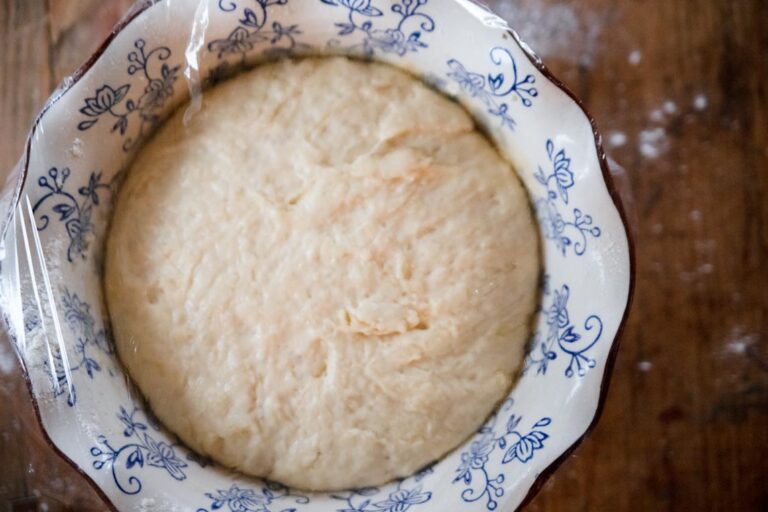
Your dough should be kneaded until it reaches window pane–when you can stretch a piece of it and see a bit of light through it without breaking. This takes longer with all purpose flour. You can see window pane in the video but plan to knead for 10 to 15 minutes. Then let the dough rest about 5 minutes before shaping.
Press the dough out to a loose rectangle then roll it up from one end. Pinch the seam shut and place it seam side down in your baking pan.
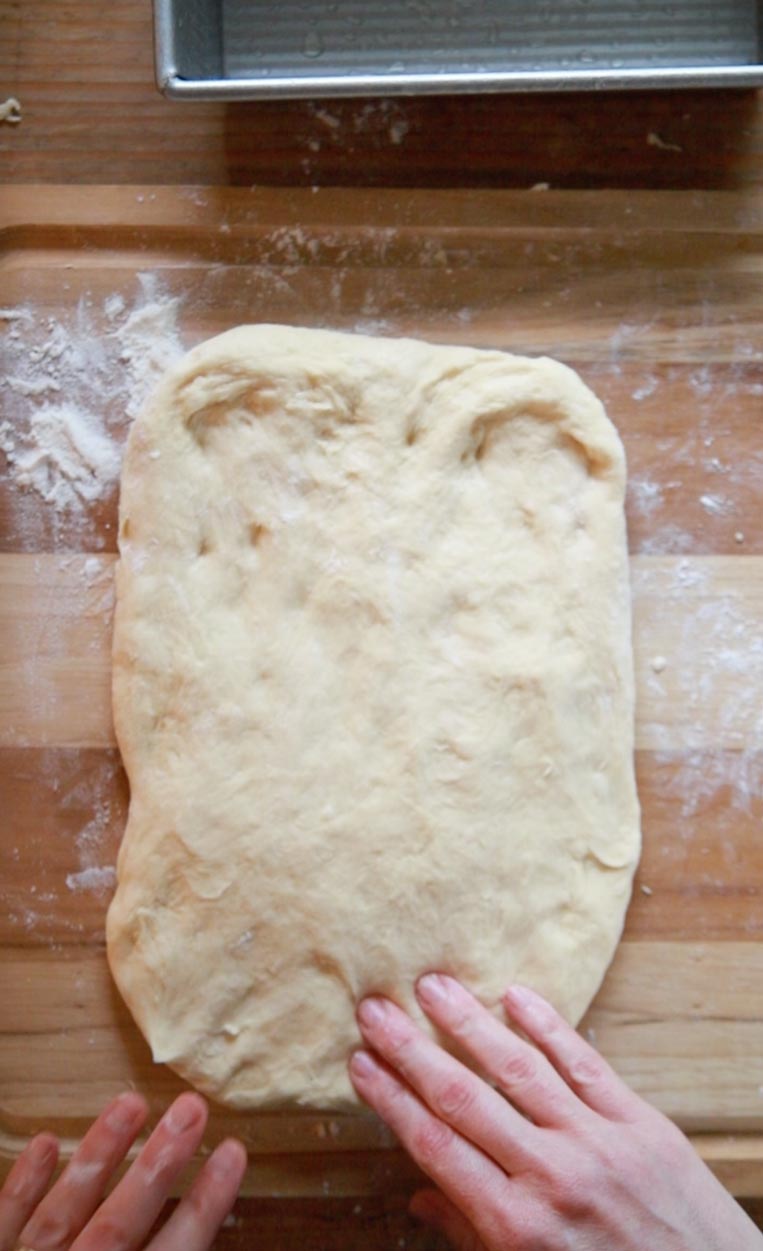
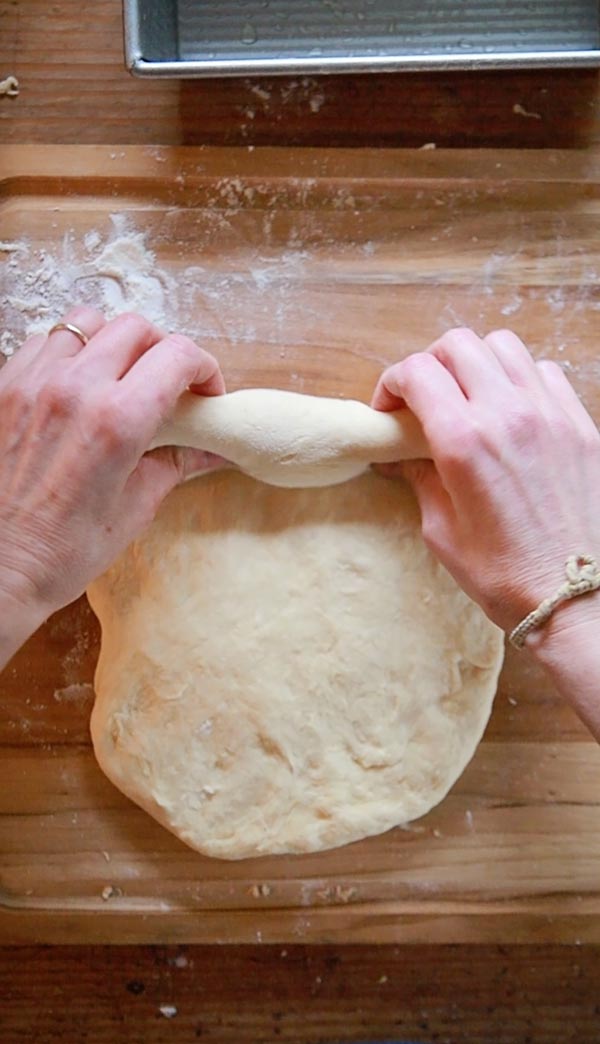
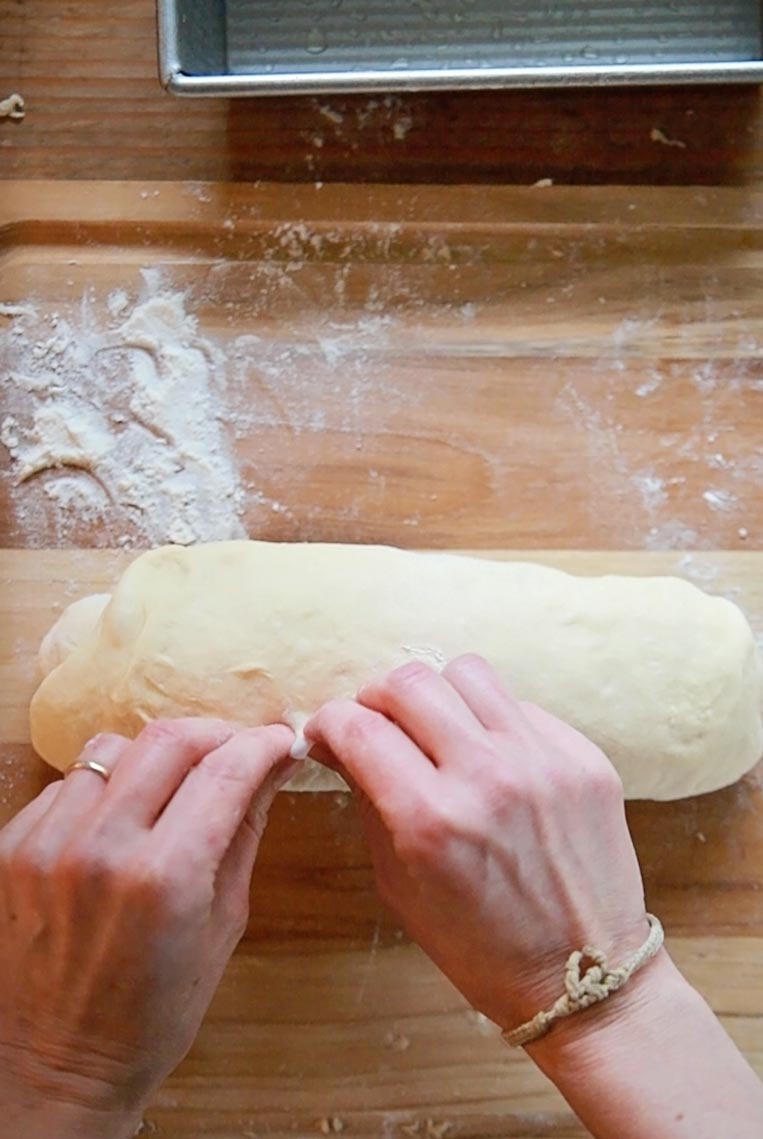
Let the dough rise uncovered until it’s about an inch above the rim of your pan or doubled in size. If you use a large loaf pan your dough won’t rise above the rim. If you decide to cover your amish white bread, use a damp towel or greased plastic wrap.
Take great care to make sure any cover doesn’t stick. Otherwise your homemade bread is ruined.
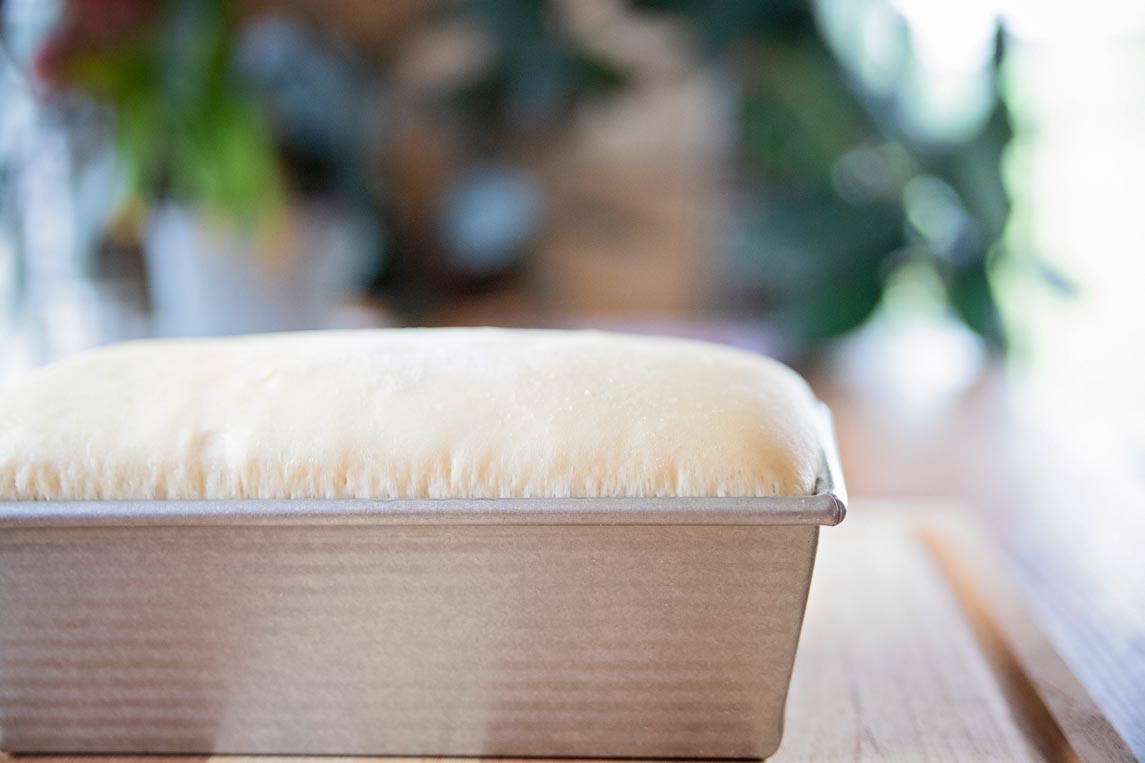
Bake your bread on the center rack in the middle of the rack (not pushed to the back or up near the door) for 25-30 minutes. You can take your bread’s temperature with a thermometer–it should read 190 or so if it’s done.
Tent your bread with foil during the last 10 minutes of baking if the crust is getting too dark.
Let it cool 5 minutes then turn it out on a rack to finish. Rub it over with a stick of butter to soften the crust.
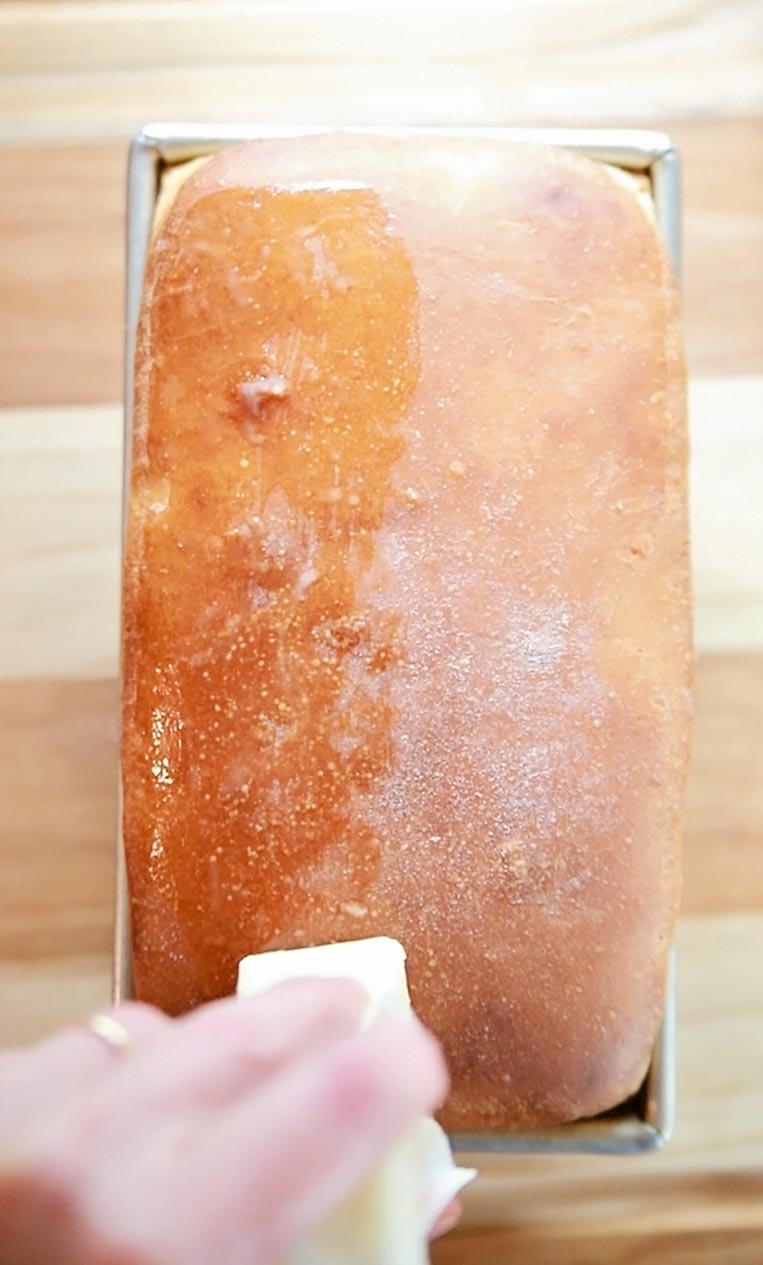
Ideas for using stale bread
Your homemade white bread will be heading toward stale in about 3 days. This really makes you think about all the junk in store bought loaves if they can last 6…8 weeks or more without molding. Gross! Make the most of your homemade efforts by using your stale bread too.
Stale bread makes amazing homemade croutons, or pulse your bread in a food processor and dry the crumbs out in a low oven (300 degrees) tossing often for bread crumbs. Store them in the freezer. Use bread cubes in an easy Panzanella salad so they can soak up the delicious flavors.
Other ways to use your Amish white bread dough

Soft Amish White Bread
Ingredients
- 1 cup lukewarm water (216 grams)
- 1 package active dry yeast (7 grams)
- 3 tablespoons sugar (50 grams)
- 1 egg
- 2 tablespoons flavorless oil (20 grams) I use avocado oil
- 3 1/2 cups bread flour (470 grams) all purpose will work
- 3/4 teaspoon salt (4 grams)
Instructions
- In a large bowl where you will be making your bread, add the water and yeast. Stir gently to combine and let it sit until you see some foam coming to the surface. This may take 5-15 minutes.
- Add the sugar and stir to combine. Add the oil and egg and use a fork to break the egg up.
- Add the flour and salt and stir to combine with a fork. Once it starts coming together, use your hands to work it in to a shaggy ball.
- Drizzle over a teaspoon of oil and pat it evenly over the surface. Cover with a damp towel or plastic wrap and let it rise until doubled in size. Just watch the dough and be patient but about an hour should do it.
- After the dough doubles, sprinkle the counter with a couple of tablespoons of flour and transfer the dough to it by using closed fingers like a scoop to scrape it from the bowl.
- Dust the top with another tablespoon of flour and knead the dough, sprinking the top and bottom with no more than 1/3 cup of flour until it is stretchy and you can see a bit of light through the dough when it's stretched–about 10 to 15 minutes of kneading.
- Let the dough rest five minutes then use your fingers to form it into a rectangle about as wide as your loaf pan. Roll it up like a sausage and pinch the seam closed. Place it seam side down in a greased and parchment paper lined loaf pan.
- Let the dough rise uncovered (see note 1) until it rises 1- 1 1/2 inches above the rim of the pan. About 45 mintues to an hour.
- 15 to 20 minutes before the bread is finished rising, preheat the oven to 400.
- Bake the bread on the center rack in the middle of the oven (not in the back, and not up near the door) 25-30 minutes. Tent with foil for the last 10 minutes if your bread starts to get too dark. You can take the temperature of your bread–it should be about 190 in the center when it's done.
- Transfer to a rack to cool 5 minutes in the pan, then turn it out and brush the top with butter for a softer crust. (Optional)
- Let the bread cool before slicing for the best texture inside.
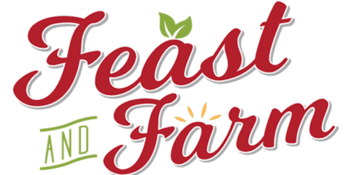
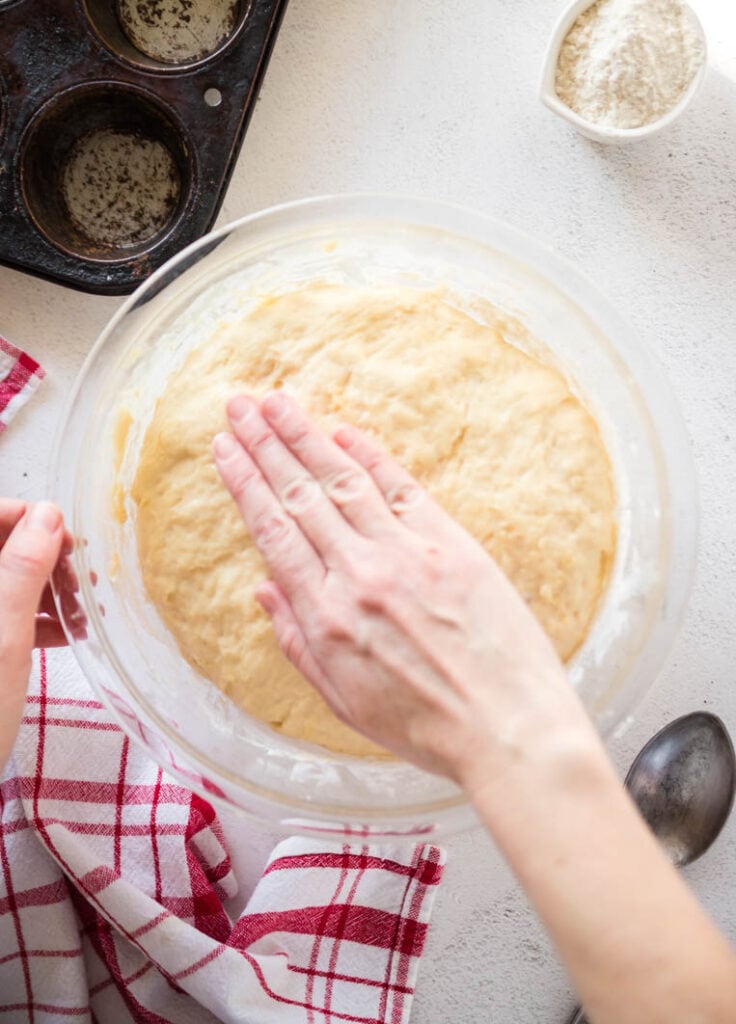

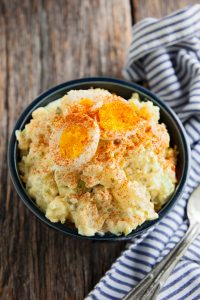

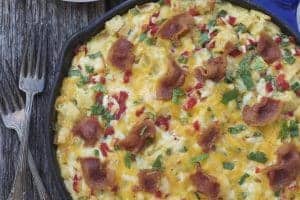
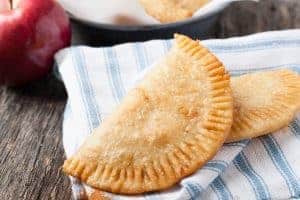
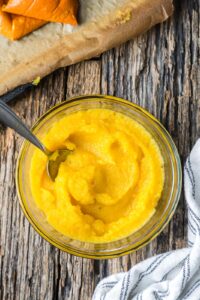

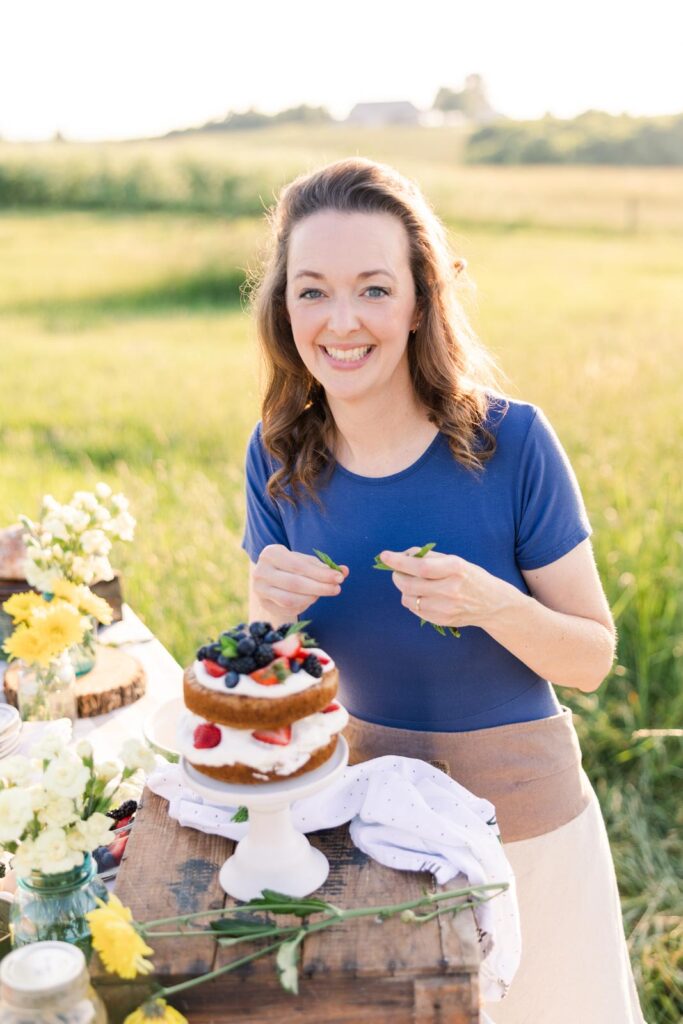
This looks so good. I am 81 but never to old to learn. Looking foreward to trying this bread.
I doubled the recipe using the 2x. I think your measurements are off. My bread is entirely too sweet, and has risen too much. Could you review and correct the amounts for 2 loaves? Thank you.
Hi JoAnn, thanks for your comment. One thing to note is that the 2x 3x business on the recipe is an auto feature that appears on all recipes on my site and can’t be turned off for one unless I turn it off for all of them. It works great for casseroles and such but bread, cakes and other baked goods may not double or triple correctly just by simple multiplication. Those measurements were never anything that I added or calculated.
That said, I also use a doubled version of this recipe to make my 100 year old yeast roll recipe (though I’ve never made it as a loaf) and it works fine but has 1/2 cup sugar (8 tablespoons) in it compared to the six tablespoons you’d get by doubling this loaf recipe so that may be too sweet for you. The lady who taught me the rolls used more apparently, but most of her other ingredients were the same, except it has a bit more salt. You can look at that recipe here if you’d like: https://feastandfarm.com/old-fashioned-yeast-rolls/#wprm-recipe-container-1975 It works flawlessly and I have never found them too sweet but you are welcome to dial back your sugar. The extra salt also helps keep the yeast in check and slows the rise some. If your loaf rose too much, just keep an eye on your ambient temperature and bake it when doubled and don’t wait for a set time to put it in the oven. Always watch your dough, not your clock. –Rachel
What is the best thing to grease the pan with?
You can use the same oil you used in the bread.
I’ve made this recipe twice and it’s come out great, even though I’m entirely new to bread making (the video accompanying this recipe was a godsend!). You’ve ignited a love for cooking I totally thought I just didn’t have (I’ve always genuinely hated being in the kitchen).
Now I’d like to dip my toes into weighing ingredients instead of measuring, and see how that goes. I noticed though that this recipe, for the sugar, says 50 grams but, 3 tablespoons of sugar is only about 30 grams. Is that a misprint or is more sugar supposed to be used when weighing instead of measuring?
Hey Kris, I’m so glad you’re finding success! Congratulations! The weight issue here is going to vary a lot based on what sugar you use and how large those granules are plus several other factors. Granulated sugar is a very, very different size from organic cane sugar, turbinado or other types of sugar. How much moisture was in my sugar the day I tested could also affect those numbers. I always use organic cane sugar and the trick with this bread is that it was taught to me by eye and customary measurements. I know how it should look. So when I converted it to grams, I made it how it should look and recorded those grams. I have gotten so much flack from people who think we have to follow the set measurements given by King Arthur for gram conversions or some other online source. So to answer your question, grams will always be more accurate and there is no change when weighing instead of measuring except the errors of measuring (how heaped the spoon is, did we level it off, and the other above mentioned variables). That’s why grams are always more reliable. Let me know if that helps or confuses you. –Rachel
I have made this several times.
the first two times it was beautiful but not great bread. I was determined to get it perfect.
3rd time was a charm as they say.
I’ve made about 12 loaves now.
Absolutely perfect!
today I’m making 2 more but this time with all purpose flour.
I hope they turn out. I have a feeling with a little extra kneeding time they will be perfect.
I can’t thank you enough for teaching me. All my family and friends think I’m the bread whisperer. 🙂
Way to go Jody! You’re amazing! –Rachel
Excellent video and easy recipe. I do leave out the egg because when my Dad and I made bread when I was a child through my 40s, we never used an egg. I hadn’t made bread since my Dad passed in 2001 because it was our thing. Now its a way to remember good times with my Dad.
This is the second time I’ve made this recipe. I wanted to make sure it wasn’t a fluke, lol. I think it turns out great and it’s the nicest loaf I’ve ever made. My Dad would love it too. Thanks for a great recipe.
LOL not a fluke 😉 I’m glad you enjoy it!
I made the bread today. We have not tried eating it yet. It looks beautiful. I was so happy. I watched your video and read this website. Thank you for making the video. I am also a RN with my BSN. I would post a picture but did not see an option to upload.
Hi Debbi, you can tag me on Instagram @feastandfarmcooks or you can always email me at rachel@feastandfarm.com. You can’t upload photos to blogs for security reasons. I’m so glad your bread turned out well! –Rachel
This bread is not only delicious but the prettiest loaf that ever came out of my oven. I’m 80 years old,
Oh congratulations Bonnie! I’m so glad you did it!
you have to follow the steps properly, but it is very good bread and very easy to make
Yes you’re right about that Alex. Bread doesn’t like it when we go rogue. 😉 Glad it worked for you.
I just made bread following your recipe/tutorial AGAIN. So good and I am happy with it. I have one issue and I’m sure it’s mine with (I hope) an easy solution. The crust on the sides and bottom are excellent. I’ve even finally learned to proof properly so no more crack on the side.
I do butter the top but find that my top crust is soft but flakes/crumbles easily. How do I fix this? More butter (I thought I put more on with this last loaf but have same issue)? I’d love to fix this.
I may not be much help on this Pat. I know what you mean and I’ve seen mine do that a time or two but never consistently. Try not buttering at all and see what happens. It could be that it’s just softening the top too much. I’ve done extensive research to come up with another answer but I’m just not finding anything. All butter has different amounts of water in it and yours could just be too wet maybe? Just a guess. I’ll keep my eye out for any information that might help and I’ll update my comment if I find anything. –Rachel